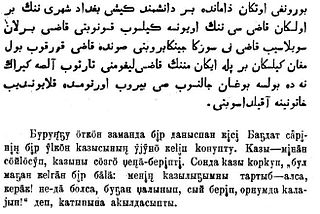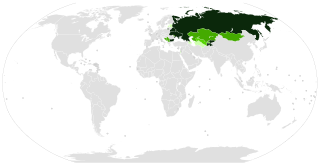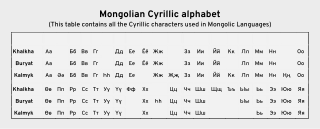
Various Mongolian writing systems have been devised for the Mongolian language over the centuries, and from a variety of scripts. The oldest and native script, called simply the Mongolian script, has been the predominant script during most of Mongolian history, and is still in active use today in the Inner Mongolia region of China and has de facto use in Mongolia.

Kyrgyz is a Turkic language of the Kipchak branch spoken in Central Asia. Kyrgyz is the official language of Kyrgyzstan and a significant minority language in the Kizilsu Kyrgyz Autonomous Prefecture in Xinjiang, China and in the Gorno-Badakhshan Autonomous Region of Tajikistan. There is a very high level of mutual intelligibility between Kyrgyz, Kazakh, and Altay.

Bashkir is a Turkic language belonging to the Kipchak branch. It is co-official with Russian in Bashkortostan. It is spoken by approximately 1.4 million native speakers in Russia, as well as in Ukraine, Belarus, Kazakhstan, Uzbekistan, Estonia and other neighboring post-Soviet states, and among the Bashkir diaspora. It has three dialect groups: Southern, Eastern and Northwestern.

Kalmyk Oirat, commonly known as the Kalmyk language, is a variety of the Oirat language, natively spoken by the Kalmyk people of Kalmykia, a federal subject of Russia. In Russia, it is the standard form of the Oirat language, which belongs to the Mongolic language family. The Kalmyk people of the Northwest Caspian Sea of Russia claim descent from the Oirats from Eurasia, who have also historically settled in Mongolia and Northwest China. According to UNESCO, the language is "Definitely endangered". According to the Russian census of 2010, there are 80,500 speakers of an ethnic population consisting of 183,000 people.
Two scripts are currently used for the Tatar language: Arabic and Cyrillic.

Izhitsa or Izhica is a letter of the early Cyrillic alphabet and several later alphabets, usually the last in the row. It originates from the Greek letter upsilon and was used in words and names derived from or via the Greek language, such as кѵрилъ or флаѵии. It represented the sounds or as normal letters и and в, respectively. The Glagolitic alphabet has a corresponding letter with the name izhitsa as well. Also, izhitsa in its standard form or, most often, in a tailed variant was part of a digraph оѵ/оу representing the sound. The digraph is known as Cyrillic "uk", and today's Cyrillic letter u originates from its simplified form.

Buryat, or Buriat, known in foreign sources as the Bargu-Buryat dialect of Mongolian, and in pre-1956 Soviet sources as Buryat-Mongolian, is a variety of the Mongolic languages spoken by the Buryats and Bargas that is classified either as a language or major dialect group of Mongolian.
The Even language, also known as Lamut, Ewen, Eben, Orich, Ilqan, is a Tungusic language spoken by the Evens in Siberia. It is spoken by widely scattered communities of reindeer herders from Kamchatka and the Sea of Okhotsk in the east to the Lena river in the west and from the Arctic coast in the north to the Aldan river in the south. Even is an endangered language with only some 5,700 speakers. These speakers are specifically from the Magadan region, the Chukot region and the Koryak region. The dialects are Arman, Indigirka, Kamchatka, Kolyma-Omolon, Okhotsk, Ola, Tompon, Upper Kolyma, Sakkyryr and Lamunkhin.

The Kyrgyz alphabets are the alphabets used to write the Kyrgyz language. The Kyrgyz language uses the following alphabets:

Three alphabets are used to write the Kazakh language: in the Cyrillic, Latin and Arabic scripts. The Cyrillic script is used in Kazakhstan and Mongolia. An October 2017 Presidential Decree in Kazakhstan ordered that the transition from Cyrillic to a Latin script be completed by 2025. The Arabic script is used in parts of China, Iran and Afghanistan.

Oe or barred O is a letter of the Cyrillic script.

Ue or Straight U is a letter of the Cyrillic script. It is a form of the Cyrillic letter U with a vertical, rather than diagonal, center line. Whereas a standard Cyrillic U resembles a lowercase Latin y, Ue instead uses the shape of a capital Latin Y, with each letter set higher or lower to establish its case. The lower case resembles the lower case of the Greek letter Gamma.
The Mongolian Latin script was officially adopted in Mongolia in 1931. In 1939, a second version of the Latin alphabet was introduced but not widely used, and was replaced by the Cyrillic script in 1941.

Numerous Cyrillic alphabets are based on the Cyrillic script. The early Cyrillic alphabet was developed in the First Bulgarian Empire during the 9th century AD at the Preslav Literary School by Saint Clement of Ohrid and Saint Naum and replaced the earlier Glagolitic script developed by the Byzantine theologians Cyril and Methodius. It is the basis of alphabets used in various languages, past and present, in parts of Southeastern Europe and Northern Eurasia, especially those of Slavic origin, and non-Slavic languages influenced by Russian. As of 2011, around 252 million people in Eurasia use it as the official alphabet for their national languages. About half of them are in Russia. Cyrillic is one of the most-used writing systems in the world.

Yo, Jo, or Io is a letter of the Cyrillic script. In Unicode, the letter ⟨Ё⟩ is named CYRILLIC CAPITAL/SMALL LETTER IO.

The Mongolian Cyrillic alphabet is the writing system used for the standard dialect of the Mongolian language in the modern state of Mongolia. It has a largely phonemic orthography, meaning that there is a fair degree of consistency in the representation of individual sounds. Cyrillic has not been adopted as the writing system in the Inner Mongolia region of China, which continues to use the traditional Mongolian script.

Russian Braille is the braille alphabet of the Russian language. With suitable extensions, it is used for languages of neighboring countries that are written in Cyrillic in print, such as Ukrainian and Mongolian. It is based on the Latin transliteration of Cyrillic, with additional letters assigned idiosyncratically. In Russian, it is known as Шрифт Брайля.
The braille alphabet used for the Kyrgyz language is based on Russian Braille, with a few additional letters found in the print Kyrgyz alphabet.
The braille alphabet used for the Kazakh language is based on Russian Braille, with several additional letters found in the print Kazakh alphabet.
The braille alphabet used for the Tatar language is based on Russian Braille, with several additional letters found in the print Tatar alphabet.













